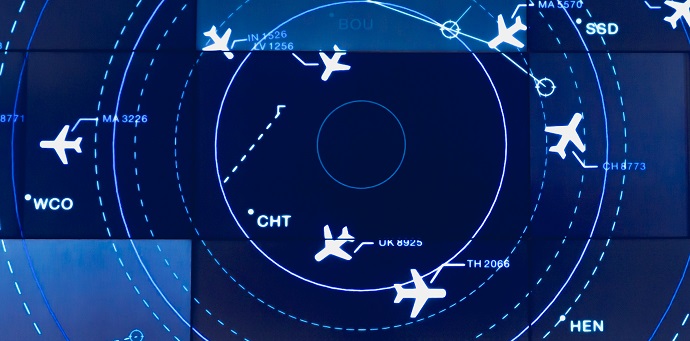Sofema Aviation Services (SAS) www.sassofia.com looks at the Automatic Dependent Surveillance ADS – B/C principles and application.
Introduction
Automatic Dependent Surveillance-Broadcast enables an aircraft to determine its position via satellite navigation (or other sensors) and periodically broadcasts it, enabling it to be tracked.
- Information received by ATC (Replacement for secondary surveillance radar, as no interrogation signal, is needed from the ground.)
- It can also be received by other aircraft to provide situational awareness and allow self-separation.
- ADS–B is “automatic” in that it requires no pilot or external input.
Note – ADS-B is “dependent” in that it depends on data from the aircraft’s navigation system.
ADS-B ground stations are far cheaper to install and operate compared to primary and secondary radar systems used by ATC.
Technical Overview
ADS-B consists of two different services,
- “ADS-B Out” and
- “ADS-B In”
o ADS-B is an integral component of the NextGen national airspace strategy for upgrading and enhancing aviation infrastructure and operations.
o Within the United States, the ADS-B system can provide traffic- and government-generated graphical weather information at no cost through TIS-B and FIS-B applications.
o ADS-B enhances safety by making an aircraft visible, real time, to air traffic control (ATC) and to other appropriately equipped ADS-B aircraft with position and velocity data transmitted every second.
o ADS-B data can be recorded and downloaded for post-flight analysis. ADS-B also provides the data infrastructure for inexpensive flight tracking, planning, and dispatch.
ADS-B Out means each aircraft periodically broadcasts information
- Identification,
- Current position,
- Altitude and
- Velocity.
Note – Typically ADS-B Out is more accurate than current radar-based systems.
ADS-B In – Is the reception by aircraft of
- FIS-B (Flight Information System Broadcast) which aircraft to receive aeronautical information such as weather and airspace restrictions through a data link;
- TIS-B (Traffic Information Service) – Provides for display of both broadcasted by appropriately equipped aircraft identity, position, altitude, speed (and other parameters) and surveillance tracks processed by regional control facilities and transmitted by ground broadcast stations;
- Direct communication from nearby aircraft.
Note – The ground station broadcast data is typically only made available in the presence of an ADS-B Out broadcasting aircraft (limiting the usefulness of purely ADS-B In devices).
Situational awareness – ADS-B in providing pilots with improved situational awareness.
Pilots in an ADS-B In equipped cockpit will have the ability to see
- On their flight display, other traffic operating in the airspace;
- Gain access to clear and detailed weather information;
- They will also be able to receive pertinent updates ranging from temporary flight restrictions to runway closings.
System Requirements ADS-B
- High-integrity satellite navigation source
o (GPS or other certified GNSS receiver) and
o Datalink (the ADS-B unit). (typically a modified Mode S transponder)
Benefits of ADS-B Technology
- View traffic information about surrounding aircraft if those aircraft are equipped with ADS-B out.
o Information includes altitude, heading, speed, and distance to aircraft.
o Receive position reports from ADS-B out participants.
- Aircraft equipped with universal access transceiver (UAT) ADS-B In technology will be able to receive weather reports, and weather radar through flight information service-broadcast (FIS-B).
- Flight information — Flight information service-broadcast (FIS-B) also transmits readable flight information such as temporary flight restrictions (TFRs) and NOTAMs to aircraft equipped with UAT.
What is ADS-C?
In a similar way to ADS-B, ADS-C (Automatic Dependent Surveillance – Contract) transmits regular and highly accurate position reports to Air Traffic Control.
However, the “Contract” element of ADS-C refers to a contract, established by the ground station, between the aircraft and that ground station. This contract is established and controlled by the ground station.
What Are The Main Differences Between ADS-B and ADS-C?
The main differences between ADS-B versus ADS-C revolve around the types of connections, how the systems are used, and the ways in which they communicate.
ADS Broadcast versus Contract
ADS-B “broadcasts” reports to any station capable of receiving them. These broadcasts are automatic and continuous and are not in response to requests from ground stations (as opposed to ADS-C).
ADS-C is a “contract” between the aircraft and a specific ground station. The contract is established and controlled by the ground station and this contract determines what information is to be sent and when it will be transmitted – the information is not broadcast to all stations as with ADS-B.
ADS-B aircraft positions are updated much more often than those operating ADS-C. As such, ADS-B provides a much more accurate picture to Air Traffic Control. The accuracy of the position reporting allows ADS-B position plots to be considered surveillance control.
ADS-C however is updated over longer periods (approx. 10-minute intervals) and such is typically used over remote and oceanic areas.
ADS Transmission Method
ADS-B is transmitted by the aircraft’s Mode S Transponder and therefore has a more limited range.
ADS-C is transmitted over the ACARS network via Satellite and therefore is not limited in range as for ADS-B.
ADS-C can operate either with CPDLC (Controller Pilot Data Link Communications) or independently on its own
Next Steps
Follow this link to our Library to find & Download related documents for Free.
Sofema Aviation Services www.sassofia.com provides the following course – EASA Regulation 965 Part SPA – Specific Approvals for Regulatory Authorities PBN, MNPS, RVSM, LVO & ETOPS – Duration 2 Days.
For details please see the website or email Team@sassofia.com
Tags:
Aircraft, SAS blogs, Airplane, ADS-B, ADS-C, Automatic Dependent Surveillance-Broadcast, Satellite navigation, ATC, Flight Information System Broadcast, Traffic Information Service, GPS, GNSS receiver, Automatic Dependent Surveillance - Contract




